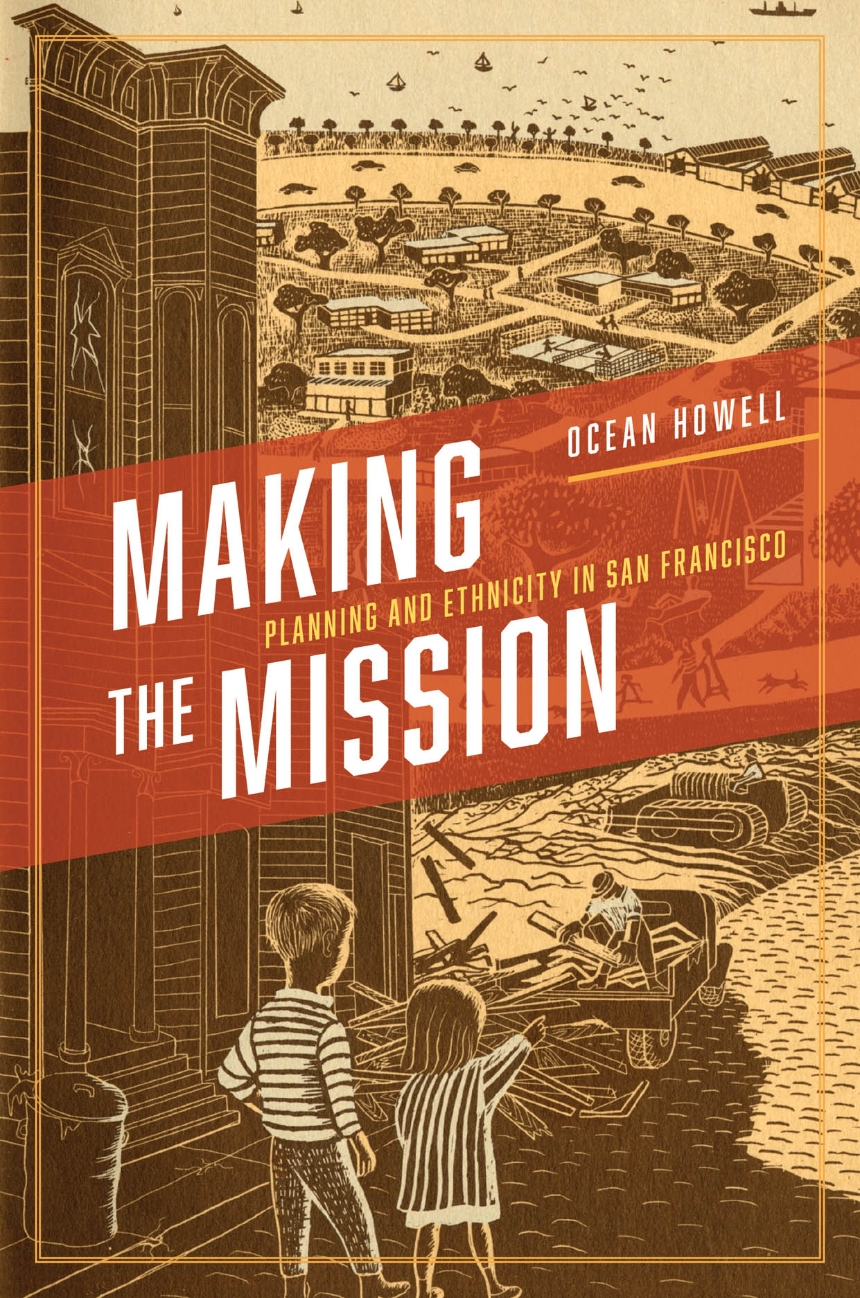Making the Mission
Planning and Ethnicity in San Francisco
Publication supported by the Neil Harris Endowment Fund
In the aftermath of the 1906 San Francisco earthquake, residents of the city’s iconic Mission District bucked the city-wide development plan, defiantly announcing that in their neighborhood, they would be calling the shots. Ever since, the Mission has become known as a city within a city, and a place where residents have, over the last century, organized and reorganized themselves to make the neighborhood in their own image.
In Making the Mission, Ocean Howell tells the story of how residents of the Mission District organized to claim the right to plan their own neighborhood and how they mobilized a politics of place and ethnicity to create a strong, often racialized identity—a pattern that would repeat itself again and again throughout the twentieth century. Surveying the perspectives of formal and informal groups, city officials and district residents, local and federal agencies, Howell articulates how these actors worked with and against one another to establish the very ideas of the public and the public interest, as well as to negotiate and renegotiate what the neighborhood wanted. In the process, he shows that national narratives about how cities grow and change are fundamentally insufficient; everything is always shaped by local actors and concerns.
In Making the Mission, Ocean Howell tells the story of how residents of the Mission District organized to claim the right to plan their own neighborhood and how they mobilized a politics of place and ethnicity to create a strong, often racialized identity—a pattern that would repeat itself again and again throughout the twentieth century. Surveying the perspectives of formal and informal groups, city officials and district residents, local and federal agencies, Howell articulates how these actors worked with and against one another to establish the very ideas of the public and the public interest, as well as to negotiate and renegotiate what the neighborhood wanted. In the process, he shows that national narratives about how cities grow and change are fundamentally insufficient; everything is always shaped by local actors and concerns.
400 pages | 8 color plates, 60 halftones | 6 x 9 | © 2015
Historical Studies of Urban America
Geography: Cultural and Historical Geography, Urban Geography
History: American History, Urban History
Reviews
Table of Contents
ONE / Neighborhood Power in Twentieth-Century San Francisco
PART I: NEIGHBORHOOD POWER IN THE “WHITEMAN’S TERRITORY,” 1906–29
TWO / Make No Big Plans: The City Beautiful Meets Improvement Clubs
THREE / Neighborhood Capitalism: Urban Planning, Municipal Government, and the Mission Promotion Association
FOUR / The Mission and the Spatial Imagination: Discourse, Ethnicity, and Architecture
PART II: THE NEW DEAL IN THE MISSION: REVITALIZING COMMUNITY, ERODING LOCAL POWER
FIVE / A New Population, Not a New Public: Latino Diversity in San Francisco and the Mission District
SIX / Economic Equality, Racial Erasure: The Spatial and Cultural Interventions of Federal Public Works Agencies
SEVEN / “No- Lining” and Neighborhood Erasure: Washington, D.C., and Downtown San Francisco Come to the Mission
PART III: PROGRESS FOR WHOM? TRANSPORTATION PLANNING, URBAN RENEWAL, AND MULTIETHNIC COALITION BUILDING, 1945–60
EIGHT / The Motoring Public and Neighborhood Erasure: The Culture and Practice of Postwar Transportation Planning
NINE / Latino as Worker: The Changing Politics of Race in the City and the Neighborhood
PART IV: RETURN TO THE CITY WITHIN A CITY: MULTIETHNIC COALITIONS AND URBAN RENEWAL, 1961–73
TEN / A “Salvable Neighborhood”: Urban Renewal, Model Cities, and the Rise of a Social Planning Regime
ELEVEN / Who Holds Final Authority? The San Francisco Redevelopment Agency and the Mission Council on Redevelopment
TWELVE / The Return to the City within a City: The Mission Coalition Organization and the Devolution of Planning Power
PART I: NEIGHBORHOOD POWER IN THE “WHITEMAN’S TERRITORY,” 1906–29
TWO / Make No Big Plans: The City Beautiful Meets Improvement Clubs
THREE / Neighborhood Capitalism: Urban Planning, Municipal Government, and the Mission Promotion Association
FOUR / The Mission and the Spatial Imagination: Discourse, Ethnicity, and Architecture
PART II: THE NEW DEAL IN THE MISSION: REVITALIZING COMMUNITY, ERODING LOCAL POWER
FIVE / A New Population, Not a New Public: Latino Diversity in San Francisco and the Mission District
SIX / Economic Equality, Racial Erasure: The Spatial and Cultural Interventions of Federal Public Works Agencies
SEVEN / “No- Lining” and Neighborhood Erasure: Washington, D.C., and Downtown San Francisco Come to the Mission
PART III: PROGRESS FOR WHOM? TRANSPORTATION PLANNING, URBAN RENEWAL, AND MULTIETHNIC COALITION BUILDING, 1945–60
EIGHT / The Motoring Public and Neighborhood Erasure: The Culture and Practice of Postwar Transportation Planning
NINE / Latino as Worker: The Changing Politics of Race in the City and the Neighborhood
PART IV: RETURN TO THE CITY WITHIN A CITY: MULTIETHNIC COALITIONS AND URBAN RENEWAL, 1961–73
TEN / A “Salvable Neighborhood”: Urban Renewal, Model Cities, and the Rise of a Social Planning Regime
ELEVEN / Who Holds Final Authority? The San Francisco Redevelopment Agency and the Mission Council on Redevelopment
TWELVE / The Return to the City within a City: The Mission Coalition Organization and the Devolution of Planning Power
